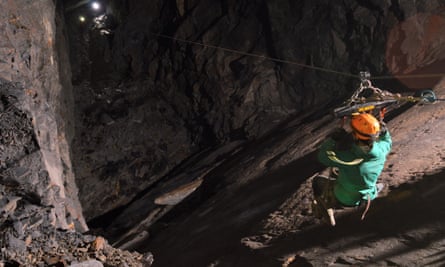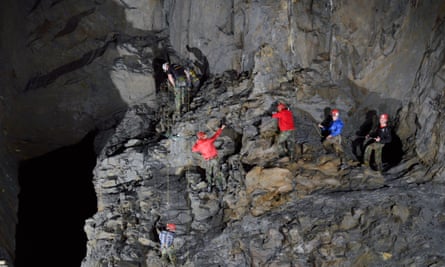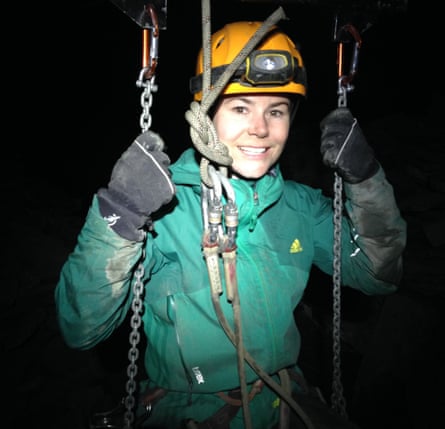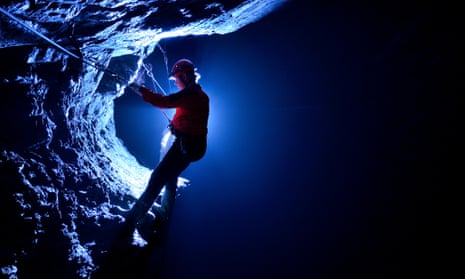“The free fall is very scary. I did it five times in a row to try to get used to it, but it was still just as frightening the fifth time as the first.” The words of Pete, a caving instructor and former soldier who fought in Afghanistan, are ringing in my ears as I stand at the top of a 21-metre abyss. The thin beam of light from my head torch barely penetrates the darkness; it is just enough to make out the edge of the cliff and the black nothingness below. I count to three – and step off.
This leap of faith is the climax of Zip Below Xtreme, a new underground adventure near Betws-y-Coed in Snowdonia, north Wales. The setting is an abandoned slate mine, and the route lends itself to superlatives: the longest underground adventure (5km); the longest underground zipline (130 metres); the deepest publicly accessile point in the UK (almost 400 metres). The trip entails a whole day below ground, and is for over-18s only (though there is an easier half-day version for over-10s).

I arrived at Go Below’s base at the Conwy Falls without concerns about the trip. In my experience, most adventurous activities are nowhere near as challenging as they sound. I was expecting a kind of underground Go Ape – fun, but not frightening. But it slowly began to dawn on me that this was a bit different. Miles, the company’s founder, talked us through the route: “We cross really scary bridges made from rotten timber, with nothing to hold on to [you are roped on though]. It’s fairly horrible, 25 metres in the air.” Apparently, people react in unexpected ways when they are in such a dark, deep environment. “We’ve had army commanders crying their eyes out.”
Caving might conjure up visions of tiny tunnels and confined spaces, but the huge Cwmorthin quarry is quite the opposite. I could walk easily through most tunnels (the workings extend for 60 miles), which open out into cavernous chambers. But that’s when things became tricky. There are three ways of crossing the void: zipline, bridge and via ferrata (cables fixed to the rock). The ziplines are great fun – you simply clip on to the rope and take a running jump, hurtling across the gap in a rush of adrenaline.

The bridges and high traverses were another matter entirely. The decaying wood no longer forms complete bridges and, after a couple of easy via ferrata stretches, there were soon no ledges to stand on. Many have very few footholds of any kind, and one, called the Corkscrew because of its twists and turns, has none at all. All are dizzyingly high, and they become progressively longer as the route goes on. I found myself clinging to cliffs with a death grip, sick with terror, my arms cramping from the strain. You have to attach your own carabiners (metal loops) to the rope as you inch along, which prevent you from falling, and at times I found myself shaking so much I struggled to clip on. There was a moment when I thought I couldn’t continue.
The fearful crossings were just about worth it to get to Goliath, however. For this 130-metre zipline ride, you sit on what looks like a child’s swing and hurtle down through a chasm in the jagged rocks. The speed has to be controlled because the line is so steep, but it still feels fast and thrilling. In fact, it was so much fun I did it twice.

Apart from the via ferrata cables and some metal rungs, the mine has intentionally been left unchanged since its working days – most of it was abandoned in the 1890s, though sections were worked until the 1990s. As Miles said: “It gives quite a good insight into the working conditions of miners.” He pointed out the odd hat and pipe, and some hobnail boot prints. Our group even found a cache of tallow candles, and managed to light one. It still smelled of bacon fat, and its meagre glow made me feel grateful for my modern torch, however inadequate it had seemed earlier. Lunch is eaten in the little painted cabins, with walls adorned by old newspapers, where the miners ate (“Welsh institutions,” said Miles).
Back at the bottom of the free fall, in which the brakes kick in a split second before you hit the floor, I looked up at Miles, 21 metres above. Surprisingly, he hadn’t yet tried the jump, leaving it to his staff to test out. From what I could make out in the gloom, he was cowering on his hands and knees. And that’s the key to this adventure – there is something to terrify everyone, even the experts. But overcoming your fear is an amazing feeling, as I’m sure Miles would agree: after an agonising wait, he finally followed me into the abyss.

Comments (…)
Sign in or create your Guardian account to join the discussion